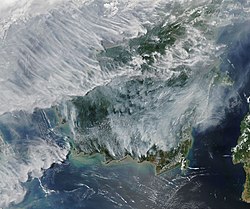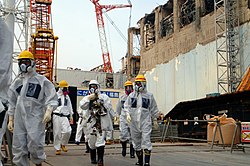The examples and perspective in this article may not represent a worldwide view of the subject.(March 2020) |
This article may incorporate text from a large language model .(September 2025) |

Environmental issues are disruptions in the usual function of ecosystems. [1] Further, these issues can be caused by humans (human impact on the environment) [2] or they can be natural. These issues are considered serious when the ecosystem cannot recover in the present situation, and catastrophic if the ecosystem is projected to certainly collapse.
Contents
- Types
- Human impact
- Pollution
- Degradation
- Conflict
- Costs
- Action
- Justice
- Law
- Assessment
- Movement
- Organizations
- Film and television
- See also
- References
- Works cited
- Further reading
- External links
Environmental protection is the practice of protecting the natural environment on the individual, organizational or governmental levels, for the benefit of both the environment and humans. Environmentalism is a social and environmental movement that addresses environmental issues through advocacy, legislation education, and activism. [3]
Environment destruction caused by humans is a global, ongoing problem. [4] Water pollution also cause problems to marine life. [5] Some scholars believe that the projected peak global population of roughly 9–10 billion people could live sustainably within the earth's ecosystems if humans worked to live sustainably within planetary boundaries. [6] [7] [8] The bulk of environmental impacts are caused by excessive consumption of industrial goods by the world's wealthiest populations. [9] [10] [11] The UN Environmental Program, in its "Making Peace With Nature" Report in 2021, found addressing key planetary crises, like pollution, climate change and biodiversity loss, was achievable if parties work to address the Sustainable Development Goals. [12]











